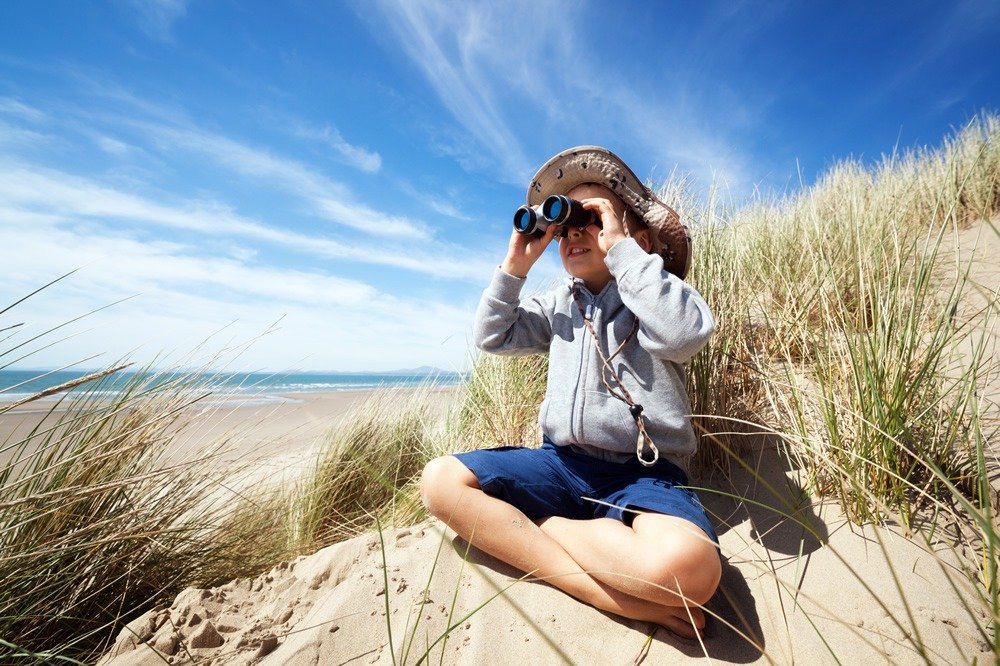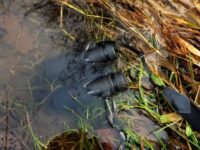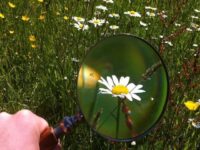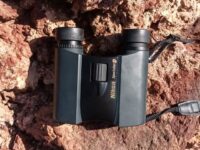This post contains affiliate links. If you follow a link I may earn a small commission at no extra cost for you.
As a parent you want to make sure that your children spend a lot of time outside, playing with friends and discovering nature. For the development of the child, it is way better to spend a large part of the day outside, than to spend too much time in front of the television or computer and only consume passively. Good children’s binoculars can help get children excited about outdoor activities and arouse curiosity and interest in wildlife and nature.
Binoculars for children
For the little future bird watchers, wildlife spotters, or junior nature lovers – it is essential to select the correct type of binoculars for your child. Binoculars for kids should be designed for children so that they can actually be used with a high fun factor. Regular Binoculars that are made for grown-ups are often unsuitable for children because they may be too big, too heavy, or the magnification is too high.
Kids Binoculars 2x to 4x Magnification best for 3 to 5-year-olds
Last update on 2025-11-07 / Affiliate links / Images from Amazon Product Advertising API
Binoculars With Magnification 8x
Last update on 2025-11-07 / Affiliate links / Images from Amazon Product Advertising API
What to look for in children’s binoculars?
When buying binoculars for children, there are other factors to consider than when buying regular binoculars for adult use. In contrast to such binoculars, children’s binoculars do not primarily focus on the very best lens quality and highest optical performance, but primarily on safety and ease of use and a high fun factor.
Eye Distance – Pupillary Distance
The Eye Distance or “Interpupillary Distance” is the distance between the centers of the pupils of the eyes, it is measured in millimeters. The distance of how far the two eyepieces are apart in binoculars is called pupillary distance. This needs to be adjustable so it can be set to the individual observer’s Eye Distance. It is simply done via the central hinge that connects the two barrels. In grown-ups, it is between 53 to 78 mm, whereas small kids may have a pupillary distance as low as 50mm. Check the binoculars specs to make sure the distance can be set to such a narrow eye-to-eye distance.
Magnification
The binoculars magnification (ie 10x30) or Power indicates how much closer an object appears. For example, when magnified 10 fold, things that are 1000 yards away, seem to be only 100 yards away.
Binoculars with a large magnification are not always best for kids. Actually, the lower the magnification, the better the child is able to deal with binoculars because high magnification binoculars require a calm and steady hand.
Depending on the age of the child, one should choose magnification. For the very little ones under 5 years of age, a binocular magnification of 3 to 4 times is enough. That doesn’t sound like a lot, but it is enough for the child to learn how to use binoculars without frustration.
For older children, binoculars with a 4-fold or 6-fold magnification are suitable, as they can concentrate longer and keep the binoculars steady.
Choose binoculars with a wide field of view
The lower the magnification the wider the field of view. Binoculars with higher magnifications have a more zoomed-in and much narrower field of view, requiring a calm hand. Stay below a magnification of 8x, then the field of view will be more suitable for children and it’s easier to handle the binoculars.
Objective Lens Size for children’s binoculars
The lens diameter also called the Aperture (ie 10x30), describes the diameter of the light-collecting lens at the front end of the binoculars. The larger the lens diameter, the better brighter the projected image appears. Unfortunately, the weight increases too.
Size and Weight
The dimensions should be compact, low weight is important so that children can get along well with the binoculars. The optimal weight for the children’s binoculars would be about 6 to 7 ounces so that the binoculars are easy to carry and hold. Only if the binoculars are easy to use without the child getting tired too quickly and losing interest, can children’s binoculars help to discover and learn new things.
Robust at Durable
Binoculars for children should be sturdy and robust so they don’t break when being dropped. A high-quality rubber coating is a good feature that can protect binoculars from damage from the inevitable fall to the ground.
Quality of children’s binoculars
Buying a quality kid’s binoculars is important, not only in terms of robustness. Know about the features of binoculars. Cheap binoculars may smell of plastic and could be made of hazardous materials. Rely on well-known brands when purchasing binoculars for children.
Binoculars for kids wearing glasses
If your kid needs to wear glasses, then make sure that the binoculars can be used by eyeglass wearers. If the eye relief is too short and the binoculars can not be used easily, kids may become frustrated and use interest in what may become a great experience. Take note of the eye relief to be at least 16mm or more.
Buying binoculars for children
Basically, when it comes to binoculars for kids, the most important aspect for young children is having fun. They want to copy what adults do. Optical performance and too high a magnification may be counterproductive because it is too complicated, the children cannot cope with it, and then quickly lose interest in it. So remember these binoculars above are toys. They allow children to learn new things while playing and to awaken their interests. In a couple of years when there is more understanding and your child shows interested in nature and watching wildlife, get a good quality pair of binoculars for your kid. Compact binoculars are also suitable, due to their low weight and small dimensions.










